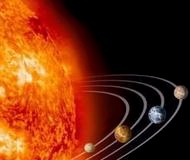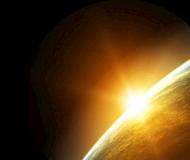
| The full report in a single page | ||
| Contents | Prev | Next |
![]()
Summary and Overview
A study shows that there was a second sun (star) in the solar system used to orbit in the asteroid belt, between Mars and Jupiter, around 200 million years ago.
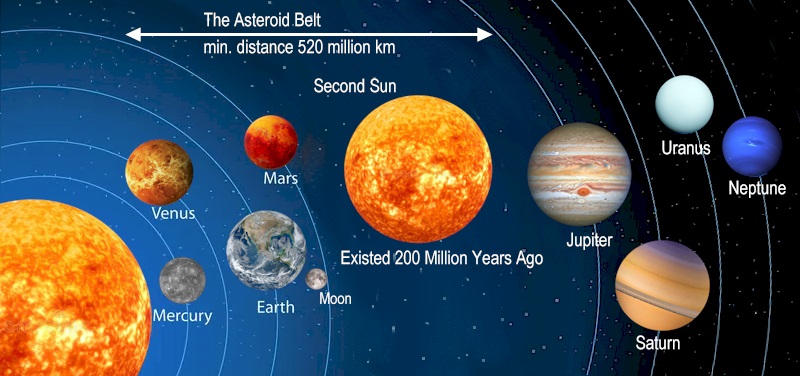
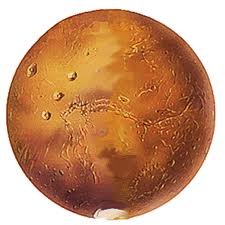
Have you ever wondered why Mars is red, covered with a layer of iron oxide (rust), and why it is polluted with radioactive materials?
Isn't it true that some dying stars produce iron oxide?
It is also true that radioactive materials are products of dying stars.
Could it be that Mars was neighboring to a star that is not in existence today?!
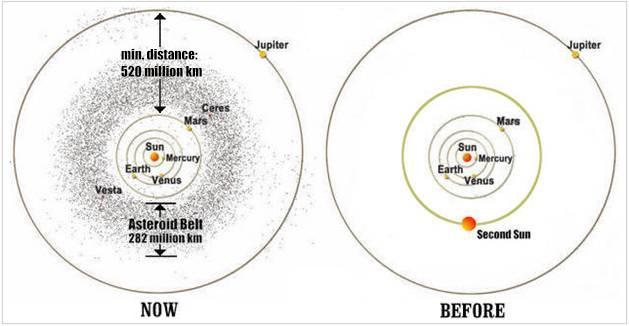
The picture above says it all. A second sun was in the sky around 200 million years ago! Some of its remains are found now in the main asteroid belt. It was a very huge sun, bigger and hotter than the current sun.
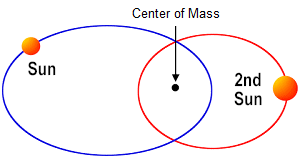
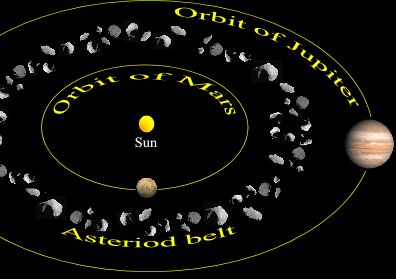
However, the orbit of the second sun, when it was fully functioning, before losing the most of its mass, most likely was different from the picture above, maybe as in the picture to the right.
The dominant theory for the asteroid belt is that the rocks and metals that are orbiting in the belt now are leftover materials, failed to come together to form a planet. Another suggestion says that there was a planet in that orbit, collided with another object and broken apart. And both of these two theories do NOT take anything outside the asteroid belt into account!
Now if we assume a space object used to orbit in the asteroid belt, and we look at it from the impact that it has left on the planet Mars in particular, and the whole solar system in general, that object cannot be anything but a star!
It is true that putting all the objects in the asteroid belt together will "not" make them a big star, and not even a small star in the size of the moon, but the objects themselves are remains of a star, signs of a star.
The solar system is no exception: "Our planet
was born as a ball of rock orbiting a single star. Or was it? New research from
UC Berkeley and Harvard University suggests that
almost all stars are born in pairs, including our own."
https://www.popularmechanics.com/...
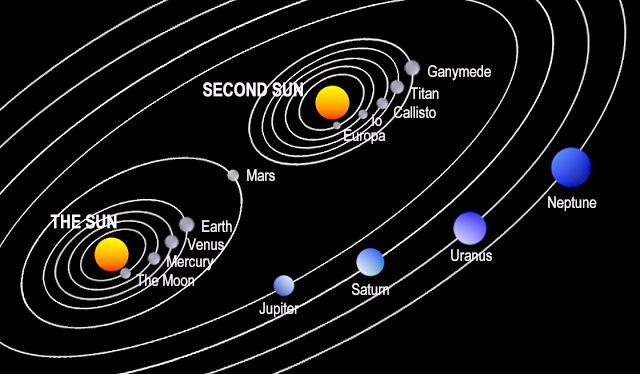
The picture above shows how the solar system was when the second sun was
fully functioning. Each sun has five planets. The closer the planet to the sun,
the smaller it is. Mars is smaller than Earth because there was a second sun on
the other side. Jupiter was the smallest gas planet... In paragraphs to follow,
we will talk about each part of this picture in detail.
"according to oxygen isotope records, early Earth
surface temperatures could have been as high as 45 – 85 degrees C!"
http://atoc.colorado.edu/~seand/...
On the other hand, it is said that the early Sun was cool, giving only about 70% of solar heat, or even less. What was the source of that extra heat?
Because the second sun was bigger and much hotter than the existing sun, it ran out of fuel much faster.
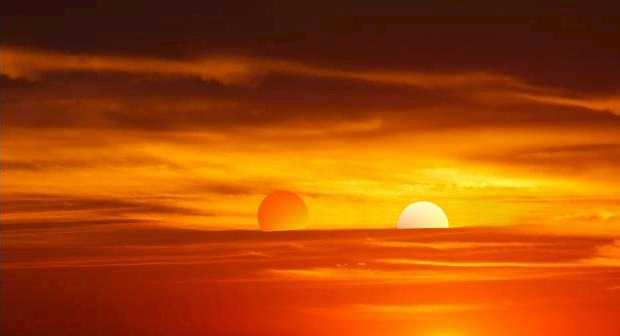
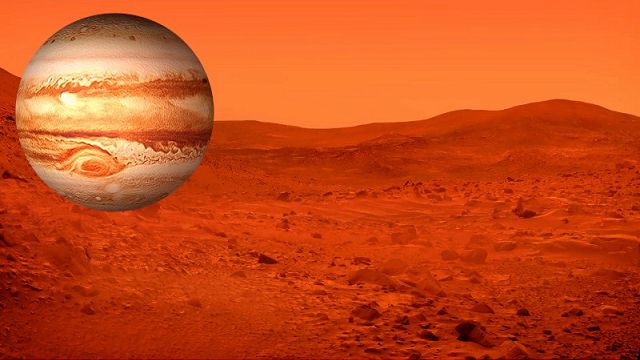
The red surface in the picture above is the surface of Mars; the spherical planet on top of it is Jupiter.
Mars is called the red planet because it is covered in rust.
Jupiter's Red Spot and the red brown shades could be rust and dust, but it
hasn't been confirmed yet: "The source of its reddish color has not yet been
established"
https://www.space.com/...
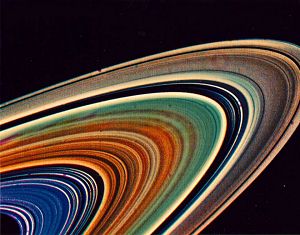
https://spaceplace.nasa.gov...
Many scientists, based on data released by space agencies, think that the
rings of Saturn contain rust, iron oxide: "They [Saturn's rings]
extend from 6,630 km to 120,700 km above Saturn's equator, and are composed of
silica rock,
iron oxide, and ice particles ranging in size from specks of dust to the
size of a small automobile."
https://phys.org/...
In the section about the rust on Mars, we will see that the inner planet that is closer to the asteroid belt, the more percentage of rust it has on its surface, and this shows that the source of rust was very close to Mars, specifically between Mars and Jupiter, and as we move away from Mars toward Mercury, the amount of rust decreases.. The picture below summarizes the result. The percentage of rust on the surface of Venus is not known.

Percentage of rust on the surfaces of the inner planets
The same result must be true for the other side, as we move from Jupiter
toward Saturn, but the space technology in the present time is incapable of
knowing what is in these planets accurately to confirm the expectations.
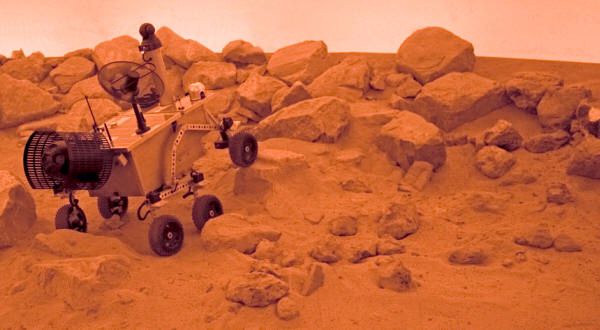
| Supernova Explosion | |
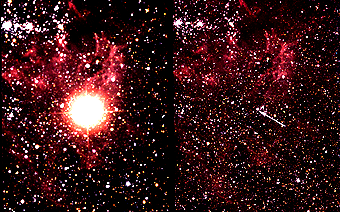 |
|
| After Explosion | Before Explosion |
| http://imagine.gsfc.nasa.gov/... | |
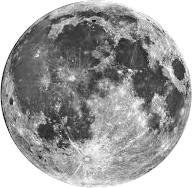 |
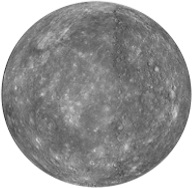 |
| The Earth's Moon | Mercury |
And if it were a planet, where was it initially?
Is it a coincidence that the moon and Mercury have very similar surface features, atmosphere and size; or that is due to the same environment the two objects have lived in for a very long period of time?
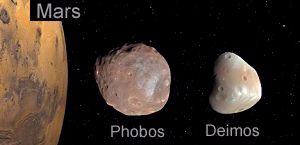
Not all moons are the same: some have the exact same features as planets, like the Earth's moon; while others are simply stones, like the moons of Mars. The total number of planet-like moons in the solar system is six, the Earth's moon is one of them, the other five used to be planets of the second sun, four of them are orbiting Jupiter now (Europa, Io, Callisto, Ganymede), and one moon is orbiting Saturn, the moon Titan.
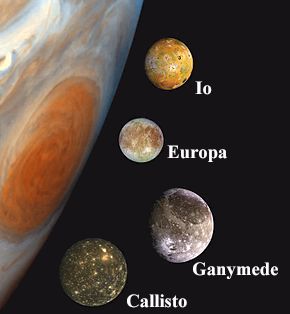
The planet Jupiter is still in a gas form because it is far away from the sun; but why are the spherical moons of Jupiter very much similar to the inner terrestrial planets? These moons have mountains, lowlands, highlands and a mantle; what else do they need to be classified as planets? To orbit a star? That is the only thing they are missing now.
The moon of Jupiter Io has over 400 "active" volcanoes, it is the most volcanically active world in the solar system.
These moons must have been planets orbiting a star at some point in time. Planets form around stars, and not around other planets.
Since there are signs of a second sun in the asteroid belt, and because the moons are relatively close to the asteroid belt, we have to assume that these moons were actually planets of the second sun.
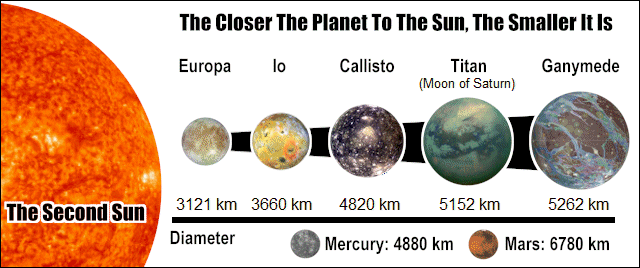
The second sun was bigger than the existing sun, so it produced more heat,
and that heat forced the nearby planets to shrink, to be smaller.
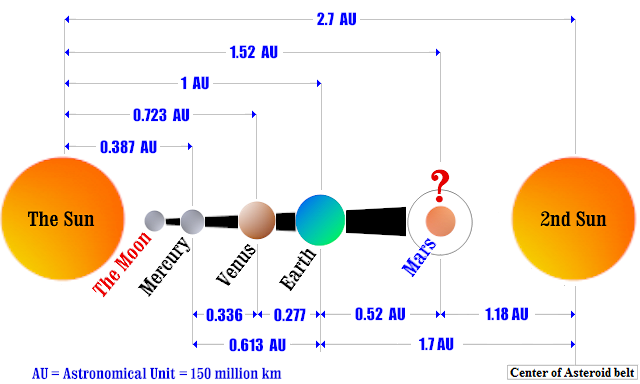
Based on the arrangement of the inner planets, we see that the closer the inner planet to the Sun, the smaller it is; and the farther the bigger. Mars is the farthest inner planet from the Sun, so it should be bigger than Earth! It is the second sun that prevented Mars from having the size that is supposed to have.
The possibility for the second sun to affect the size of Mars is when the two suns come close to each other in their elliptical orbit, as in figure C in the picture below.

Unlike Earth and Venus, the orbit of Mars now is different somehow (see the picture below). Mars must have been in this long elliptical orbit since the days of the second sun, but when the second sun was fully functioning, its gravitational pull on Mars most likely was very strong, pulling the planet all the way very near its own planets.
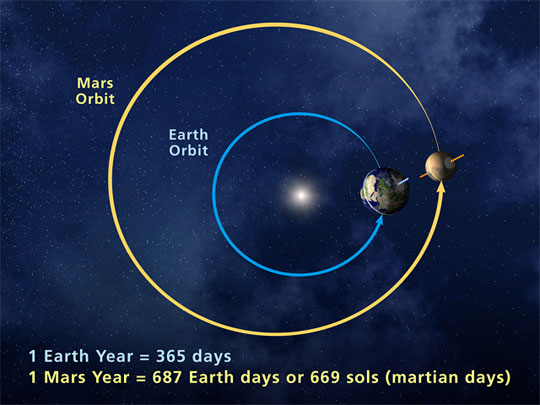
The Orbit of Mars
"Mars also has the second most eccentric orbit
of all the planets in the Solar System (0.0934), which makes it a distant second
to crazy
Mercury (at 0.20563)."
https://www.universetoday.com/...
Eccentric orbit value in the quote above is the number that shows how much a planet's orbit deviates from being perfect circle.. Perfect circle doesn't exist.
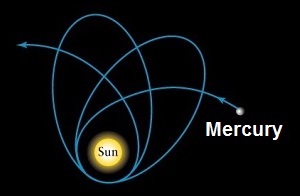
The "crazy" orbit of Mercury mentioned in the quote above is caused by a missing planet between Mercury and the Sun. That planet is currently the earth's moon, it was initially the first planet next to the sun.. More on this point in the next section, The Solar System Formation.
When Mars at its farthest point from the existing sun, it comes very close to the planets of the second sun, as in the picture below. This is where the second sun affected Mars and prevented it from having the size that it should have.

The Gas Planets:
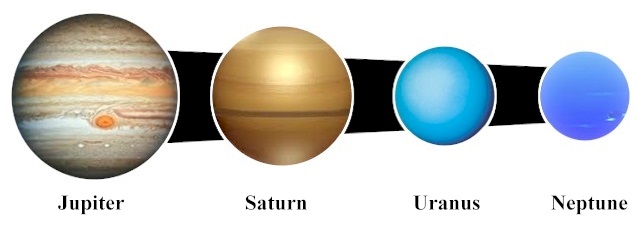
Gases from the dying second sun attracted to gas planets and increased their gas volume.
Unlike the inner planets, the sizes of the gas planets are in reverse order: the planet that is closer to the Sun, the bigger it is; not just bigger, but too much bigger! Jupiter has a mass of about 317 the mass of Earth. The Great Red Spot itself is so big that three Earths would fit in it easily. Saturn's mass is about 95 the mass of Earth.


What will happen if you boil water on fire? You will see the water steam goes to the ceiling; and if the ceiling is divided into two parts, one part is cold and the other is hot, you will see the water steam goes to the cold part. The second law of thermodynamics explains this process as follows: heat flows spontaneously from a hot to a cold body.
The second sun, by the end of its life, failed to burn fuel and convert it to
light; so where do you think the hot fuel will go? To the cold body! And that is
exactly what happened, most of the remaining fuel, rust and dust, have gone to
the cold bodies, Jupiter and Saturn; Uranus and Neptune were not affected that
much because they are very far away from the asteroid belt, the final orbit of
the second sun.
All the planets in the solar system were initially like Neptune, made of the exact chemical composition (more on this point in the next section), the planets that are close to the sun solidified, whereas the ones that are far away from the sun remained in a gas form.. The planet that is closer to the sun is smaller; this rule applies to all planets in the solar system, including the gas giants.
| Planet |
Distance from Sun relative to Earth |
Diameter relative to Earth |
Mass relative to Earth |
| Mercury | 0.387 | 0.383 | 0.0553 |
| Venus | 0.723 | 0.949 | 0.815 |
| Earth | 1.0 | 1.0 | 1.0 |
| Mars | 1.52 | 0.532 | 0.107 |
| Jupiter | 5.20 | 11.21 | 317.8 |
| Saturn | 9.58 | 9.45 | 95.2 |
| Uranus | 19.20 | 4.01 | 14.5 |
| Neptune | 30.05 | 3.88 | 17.1 |
The table above has been extracted from a long table at the following link:
https://nssdc.gsfc.nasa.gov/...
Uranus is bigger than Neptune in diameter, but smaller in mass.. It is not following the size and mass sequence of the gas planets! Something abnormal must have taken place in the planet's history that altered its size or mass.
The size and mass mismatch of Uranus shows that the original composition of the planet has been altered. The direction of change started from Jupiter toward the outside of the solar system, otherwise the diameter of Neptune would have been bigger than that of Uranus. Therefore: by following the direction of change we see that Uranus was smaller than Neptune, Saturn was smaller than Uranus, and Jupiter was the smallest gas planet, as shown in the picture below:
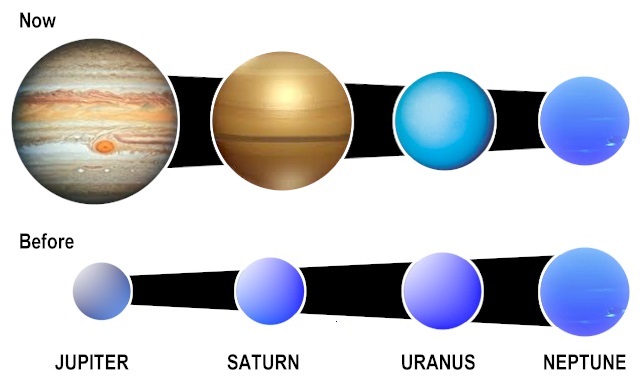
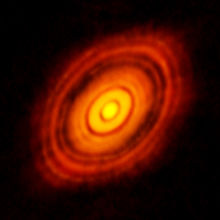
http://en.wikipedia.org/...
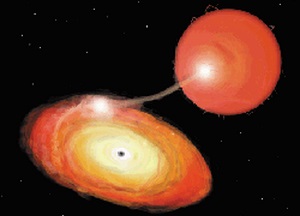
http://imagine.gsfc.nasa.gov/...
The so-called protoplanetary disks do "not" make new planets as assumed by the Nebular theory. They are just debris disks of dying stars. In addition to the dust and gas, they also contain rocks, metal, and many other different materials. They are basically the same as the asteroid belt, but much newer.
"the debris
disks around these examples (e.g. Vega, Alphecca, Fomalhaut, etc.) are probably
not truly 'protoplanetary', but represent a later stage of disk evolution
where extrasolar analogs of the asteroid belt and Kuiper belt."
http://en.wikipedia.org/...
Some observations have shown that the source of the material that makes the disk is a companion star. So if there were no companion star (second sun) in the solar system, the asteroid belt wouldn't have existed! By the end of its life, the second sun created a "protoplanetary" disk, or better say a "debris" disk; and the asteroid belt now contains remains of that disk.
Most of the dust and gas that were in the asteroid belt have collected on top of Jupiter and Saturn and increased their gas volume. Some other amounts have fallen on the inner planets, and mixed with the planets' soil, and participated in making the strong cement that glues mountain rocks together.
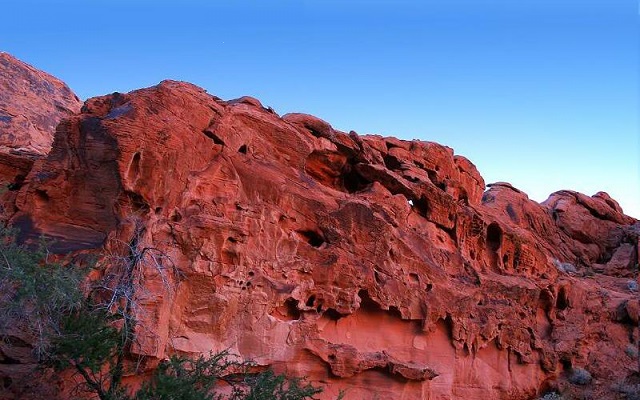
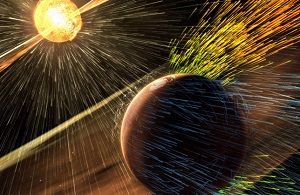
NASA studied the atmosphere of Mars and concluded
that it was stripped from the top: "The enrichment of heavier isotopes
measured in the dominant carbon-dioxide gas points to a process of loss from the
top of the atmosphere"
http://www.nasa.gov/...
How this happens: "a process that is thought to be driven by interactions
with the solar wind."
http://www.scientificamerican.com/...
Note that the so called -- solar wind -- isn't air, but a solar radiation of electrically charged particles. Solar wind of stars other than the sun is called stellar wind.
Title: "Mars Atmosphere ERODED by Sun Activity"
http://astronaut.com/mars...
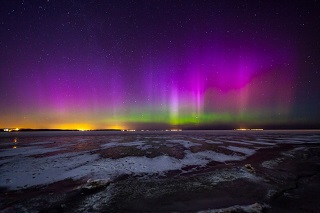
https://cosmosmagazine.com/...
Because of the atmosphere of Mars, some scientists think that the solar wind of
the existing sun was the cause: "the solar wind is thought to be very strong
at the beginning of our solar system history."
http://bunewsservice.com/...
Nobody can say that the solar wind of the existing sun has no effect at all on the atmosphere of Mars; the picture to the right shows that it penetrates the Earth's atmosphere and causes auroras near the poles, but saying that it is the one that wiped out the atmosphere of Mars cannot be correct. If this was the case, it would have affected the atmosphere of Earth much more, and for the simple reason: Earth is much closer to the sun than Mars.
Some scientists assume the magnetic field and gravity of a planet is keeping the planet's atmosphere.. The gravity of Titan is less than that of Mars, and even less than the gravity of the Earth's moon, and does not have a magnetic field, but it has an atmosphere that is denser than Earth's.
Titan interacts directly with the solar wind in the same way as Mars does: "Cassini
[spacecraft] Catches Titan Naked in the Solar Wind"
https://www.jpl.nasa.gov/...
Venus also does not have a global magnetic field, much closer to the sun than Mars, but its atmosphere is much denser than Earth's.
The planet's Gravity and magnetic field may play a very minor role in keeping the planet's atmosphere, but only the strong solar wind is the one that destroys it.
All of the Jupiter's 4 moons (Europa, Io, Callisto, Ganymede) have very thin atmosphere. No studies have been conducted on these planet's atmosphere, but most likely it has been stripped away from the top, just like Mars, by the solar wind of the second sun.
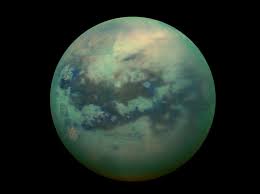
It looks like the fourth planet of the second sun, Titan, moved to Saturn very early and saved its atmosphere. But why Saturn and not Jupiter? As said before, Jupiter was smaller at that time. The second has not yet entered the phase of producing gases, it was still functioning and producing light, but with a lot of internal problems.. This leads to a conclusion that dying stars produce huge amounts of solar wind before they enter the phase of releasing gases and creating metals. Mars atmosphere was erased at this stage, the stage of solar wind, and this shows that it was very close to the second sun, far away from its current position, otherwise the solar wind of the second sun would have affected the Earth's atmosphere very severely.
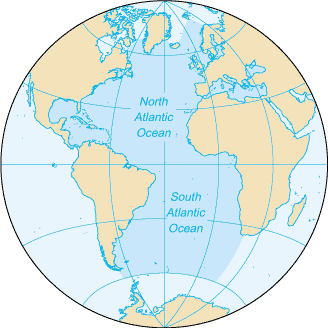
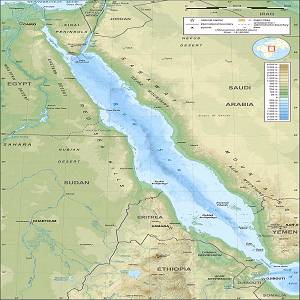
Many earth and space theories have been formulated without considering a second star in the solar system. As a result, they ended up either partially or completely incorrect. For example, two theories exist to explain the continental edges that fit together on the world map. The dominant theory is the Continental Drift, also called, Plate Tectonic. The other theory is the Expanding Earth. The plate tectonic theory states that the continents before 200 million years were united in a very vast ocean, and then they started to move. Even though this theory seems to explain the continental edges that fit together on the Atlantic ocean and other smaller seas, it completely ignores the same phenomenon on the Pacific! The Expanding Earth theory does not ignore the continental edges that fit together on the Pacific, but it does not give a reason for why the earth is expanding!
Many changes and events have taken place in Earth and other planets throughout the history of the solar system, but most of them are still a puzzle. Something must be missing somewhere!
Earthquakes, tsunamis and volcanic eruptions are still occurring, but because the specialists are unaware of what has happened in the past, in order to know how the earth works today, these disasters remain a mystery.
In this article we will try to rework some of the Earth and space theories to see how things will turn out when taking the second sun as a prime factor in the equation of the solar system.
| The Permian - Triassic Extinction Event.. This mass extinction was caused by the dying second sun, it took the Earth 30 million years to recover; the long lasting period of the extinction indicates that the cause was present all of this time |
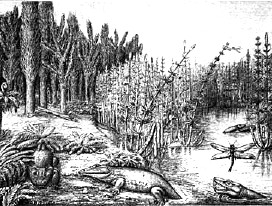
"It was almost the perfect crime. Some perpetrator -- or perpetrators --
committed murder on a scale unequaled in the history of the world. They left
few clues to their identity, and they buried all the evidence under layers
and layers of earth. The case has gone unsolved for years -- 250 million
years, that is." |
The Second Sun -- Just like many types of stars in the final period of their life, and because of the changes and events that have happened in Earth and other planets in the solar system, the second sun, most likely, have fired extremely powerful gamma rays by the end of its life. These rays have led to major changes and disasters in Earth, and also changes in the other inner planets!
According to theories, stars produce light by nuclear fusion. The nuclear fusion produces gamma rays, and then these gamma rays are converted to light. On the other hand, observations have shown that some dying stars fire strong gamma rays; this means that these stars at a very late stage of their life failed to convert the produced gamma rays to light.
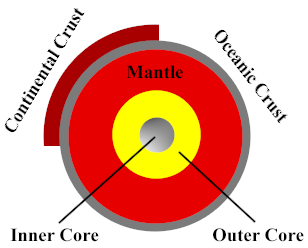
Earth Layers
The emitted gamma rays most likely have caused ionization (chemical action/reaction process) of gases inside the Earth's mantle (the layer that is just below the crust) that led the mantle to explode and the Earth's crust to break. When that happened, life extinction resulted and almost all life on Earth died out, including insects. This is the Permian –Triassic extinction event.
Large quantities of meteoroids and asteroids have fallen down from the sky and gone all the way down to the mantle via large holes and trenches that were resulted from the explosions that have taken place inside the mantle.
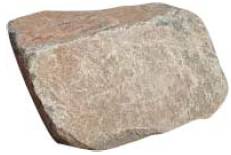
These meteoroids were actually igneous rocks, and they were originally part of the dying second sun, manufactured by the second sun in the phase of making metals and chemicals. They were thrown by the second sun and then they came to orbit the planets. After they fell on Earth, they formed the ocean floor and rocky mountains, as well as the lowlands and mountains in the other inner planets.
Few Rocks: "there are few
250 million-year-old rocks left on Earth. Most have been recycled by our
planet's tectonic activity"
http://science.nasa.gov/...
The absence of rocks is attributed to a "theory" that hasn't been proven to exist before 200 million years! If the carbon dating of the "few" rocks is correct, they are very likely meteorites landed on Earth from outer space.
We have seen earlier that the gas planets were filled with gases according to their distance from the second sun, based on the 2nd law of thermodynamics, but the case with the rocky planets is different, the amount of rocks they got was proportional to their original size; bigger planets attract more rocks than smaller planets; this can be seen now, bigger planets have more moons and rocks orbiting them than smaller planets, the same thing happened in the past.
Most, if not all, of the base metals on Earth such as iron, magnesium, platinum, gold and silver have come from the second sun. They arrived on Earth either as pure metals or as ingredients of rocks, which are the same rocks that contain metals now, specifically the rocks that make up the ocean floor and mountains, plus the molten rocks inside the mantle.
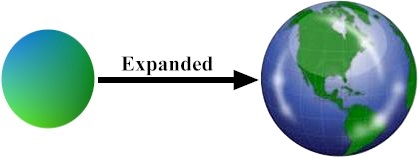
Because of the added material, the earth has expanded, and its mass has increased. The expansion happened only once, and the earth is "not" continuously expanding as stated by the Expanding Earth theory. And because of the water that is filling the ocean basins, the land chunks (continents) started to drift! There was no continental drift before the expansion of Earth.
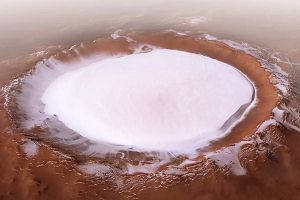
The ocean waters came from the dying second sun; arrived on Earth as as ice
asteroids, like the one that is found on Mars now, in the picture to the right.
This may sound strange, do stars produce water? Water is oxygen and hydrogen,
chemical elements manufactured inside dying stars: "Astronomers have detected
a massive cloud of water vapor around an aging
star."
http://science.nasa.gov/...
Before the formation of the ocean floor, only shallow water existed on Earth in lakes and rivers. Regarding mountains, only sandstone mountains existed in the past. The only mineral that can be found in the old sandstone mountains is coal. Even though coal is not metal, but people have to mine it, that is why it is classified as mineral.
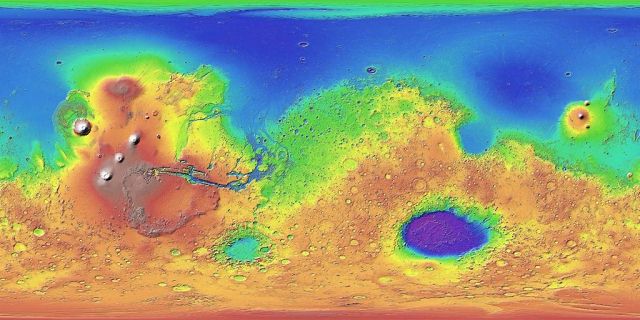
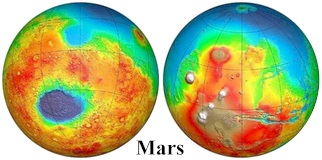
The other inner planets have also expanded. The lowlands (blue) on the other planets, which are equivalent to the ocean floor on Earth, are added parts, plus mountains. According to the crater counting technique, the surface of a planet that has more craters must be older than the surface, on the same planet, with less craters.. All lowlands, in all planets, have very few craters compared to the highlands! This is a clear and visible indication that they have been created at a very late time. The lowland on Earth is the sea floor; no sea floor on Earth is older than 200 million years. After knowing this about the lowlands on other planets, the assumption of Earth recycling the sea floor and mountains every 200 million years becomes invalid and without any basis. The earth generally is no different from the other terrestrial planets in the solar system.. The only difference between Earth and the other planets is water; and must be the factor, or at least the main factor, that causes continents to drift on Earth; before the expansion of Earth and the added water, there was no continental drift.
The following quote is from an article about the Permian-Triassic extinction event.
"The Earth was engulfed in widespread volcanism at the
time of the extinction."
http://science.nasa.gov/...
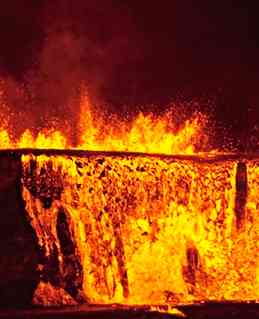
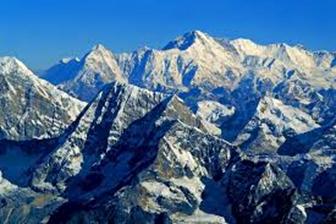
As said earlier, the fired gamma rays by the second sun caused ionization of gases inside the Earth's mantle that led to huge increase in gas pressure that resulted in explosions.
Rocks started to fall from space (originally were parts of the second sun) and go all the way down inside the open trenches. Some of these rocks were melted inside the Earth's mantle and reproduced to make the sea floor. Other rocks were stacking up inside other trenches and building mountains. At the same time the Earth was expanding. The evidence that supports that this was actually the case is that no seafloor is older than 200 million years and no rocky mountain is older than 200 million years, all over the Earth. In addition, there is no physical evidence to show any tectonic activity before 200 million years.
What made the falling rocks to fall inside the open areas is that moving ionized gases create a magnetic field, and the falling rocks contain iron and magnetism. So the rocks were attracted to these areas more than anywhere else.
Some mountains have remained underground for a long time, and then raised by a rising magma from the mantle. Some other mountains are still being raised until this day.
The sea floor is changing size, enlarging in some places and shrinking in other places, depending on the way the Earth balances the water on its surface.
What we have here is NOT a natural process that is governed by a predetermined natural law, but an accident that caused a sudden change; so the results are unpredictable. Now, for example, the Atlantic is expanding and the Pacific is shrinking; but will this process continue forever like that? It is up to the Earth to decide. The same thing is true for mountains; it has been noticed that the Himalaya Mountain is still rising! But for how long will this rise continue? It will certainly stop in one day, just like the other mountains that have already stopped; and another mountain may start to rise, or may not.
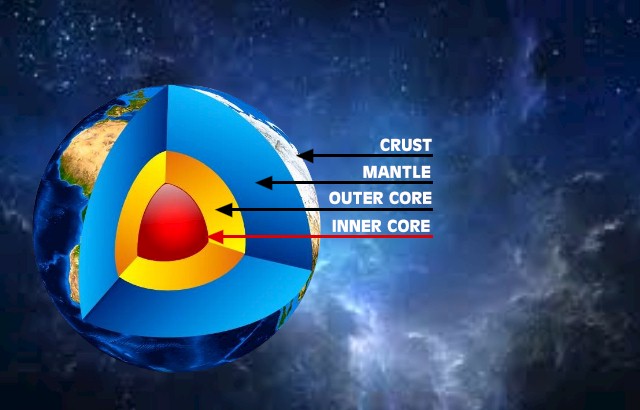
The earth inner core, that is made of iron and nickel, isn't as old as the earth itself, as some might think, but it is an added part at a very late time, and it is getting bigger. Some scientists give it an age of about 500 million years only, compared to the Earth estimated age 4 billion years.
"The inner core is a relatively recent addition to
our planet and establishing when it was formed is a topic of vigorous scientific
debate with estimates ranging from 0.5 billion to 2 billion years ago."
http://www.sciencedaily.com/...
What applies to the inner core of Earth must also apply to the other solar system planets, and we have to initially assume that all of them got their inner core at a very late time.
It looks like the fallen rocks that stayed inside the mantle got melted and released their metallic elements, including iron. The extracted iron started to sink to the earth center and concentrate there to form the inner core. So the formation of the earth core is an ongoing process until this day and it is getting bigger because the rocks are still releasing metal and the metal is sinking to the earth center. Since there was no iron or any other metal on Earth before 200 million years, it is impossible for the earth core to be older than 200 million years.
The young age of the Earth metal core adds evidence that shows that Earth had no metal at all before 200 million years, not even inside the earth internal layers.

Left: Banded Iron Formation (BIF). Right: Star debris disk (the source of BIF)
Banded Iron Formations (BIFs) are layers of iron on old sedimentary rock (sandstone), supposedly formed in sea water of the ancient seas and bacteria releasing oxygen. The assumption here is that BIFs were formed when the Earth received huge amounts of waters mixed with rust from the second sun debris disk. The supposed ancient seas are nothing but the waters from the second sun.
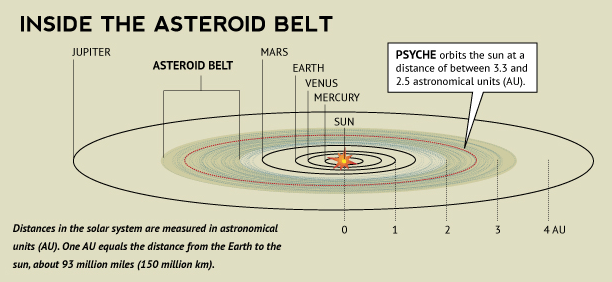
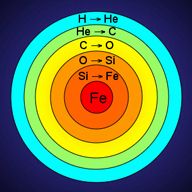
The picture above shows the orbit of a metal (iron) asteroid in the main asteroid belt, called, Psyche. It is almost in the middle of the belt. It has a diameter of about 250 km. It has not been visited or investigated yet. It could be the inner core of the second sun or a major part of it. Note that there is NO inner core in stars that are functioning normally, but some stars by the end of their life, when they start making metals, they develop what can be called a star inner core.
Some think that this metal asteroid is an exposed inner core of a planet failed to form, on the assumption that the inner core of a planet is made first. The late addition of the earth's inner core proves this assumption incorrect.
![]()
| The full report in a single page | ||
| Contents | Prev | Next |
